Picture this: You’ve just explained a brilliant idea, but all you get are blank stares and polite nods. You might think to yourself “How can I explain things better?”
Sound familiar?
Whether you’re a leader, teacher, or professional, the gap between knowing something and explaining it effectively can feel like a canyon.
But here’s the good news: clear explanation isn’t a magical talent—it’s a skill you can master.
And in 2025’s increasingly complex world, it can’t be your secret weapon for success.
Ready to learn more?
Let’s dive in!
Why Clear Expectations Matter
The ability to explain complex ideas simply isn’t—it’s essential for success.
Whether you’re pitching to clients, teaching students, or sharing insights with colleagues, clear explanations increase understanding, engagement, and action.
A study found that 68% of employees admit to wasting too much time on productivity due to ineffective communication.
If 68% of employees report losing productivity due to ineffective communication, that means nearly 7 out of 10 employees are struggling with unclear messaging, poor collaboration, or miscommunication.
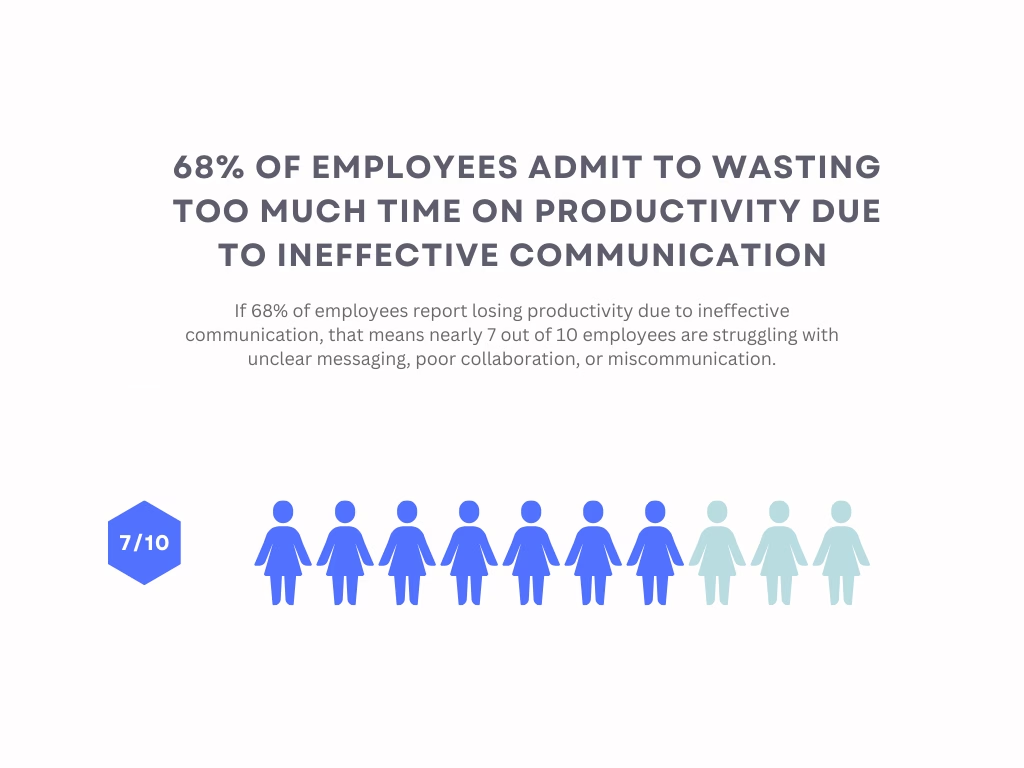
Now, imagine a company with 1,000 employees—this statistic suggests that 680 of them are wasting time due to communication issues.
This puts the issue into perspective: ineffective communication isn’t just a minor inconvenience—it has a massive impact on productivity and business performance.
The good news?
You don’t have to be part of the 68% struggling with ineffective communication.
There are practical ways to ensure your explanations hit the mark every time.
Start with Why the Audience Should Care
The most powerful explanations begin by addressing the question burning in every listener’s mind: “What’s in it for me?”
Before diving into details, establish relevance by connecting your topic to your audience’s goals, challenges, or aspirations.
For example, instead of jumping straight into how a new software works, start by highlighting how it will save them time or solve their biggest daily headache.
Focus on Benefits, Not Features
People don’t care about the features—they care about what those features do for them.
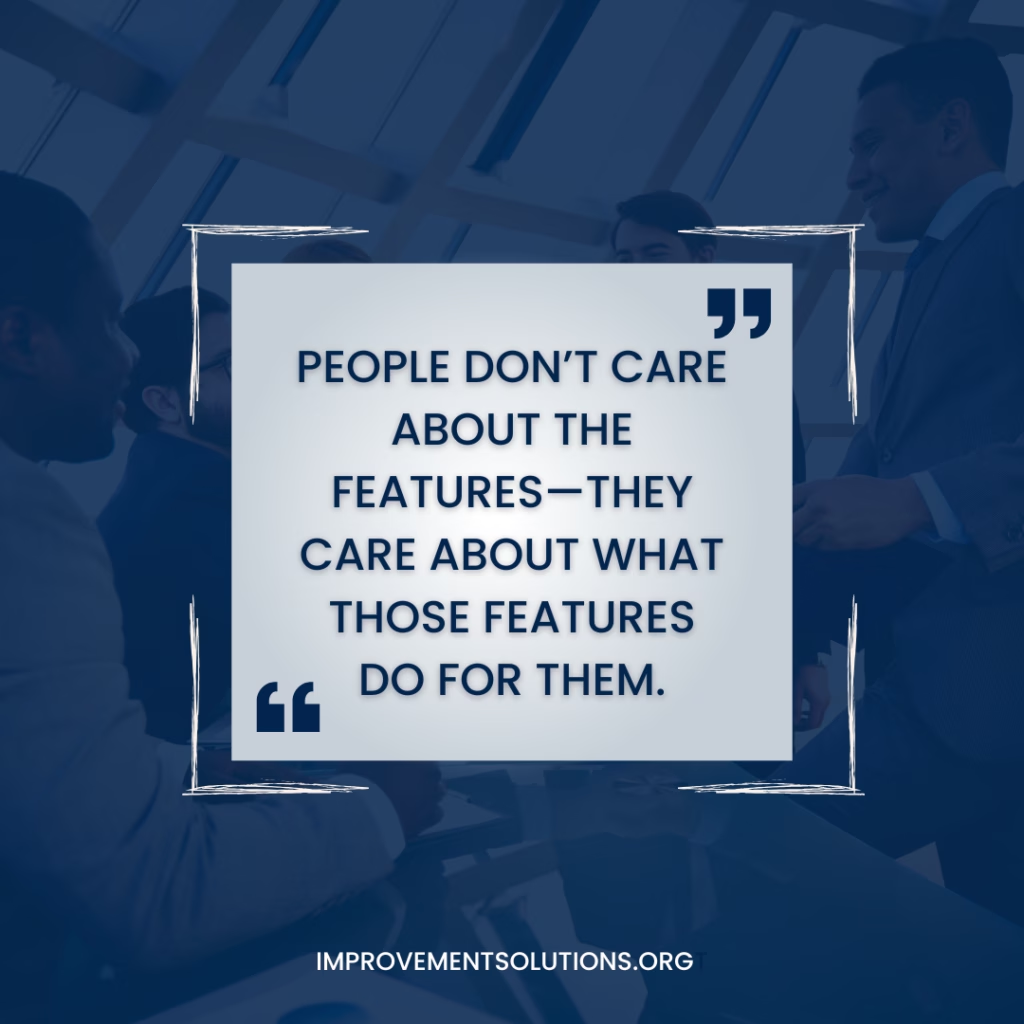
Steve Jobs didn’t introduce the iPod by saying it had a 5GB hard drive. He said, “1,000 songs in your pocket.”
He didn’t overwhelm the crowd with facts about how the phone works. Instead, he focused on how this device is going to improve people’s lives.
This is a great lesson in how to communicate.
People don’t need to know all the technical stuff.
What they really care about is how something will make their life easier or solve a problem.
For example, if you’re introducing a new project management tool, don’t focus on its features. Instead, say something like, “This tool will reduce your meeting time by 50% and help your team meet deadlines consistently.”
When you’re sharing your ideas, focus on the outcome—the difference it will make for the person you’re talking to.
This way, your audience doesn’t just understand what something does; they see why it matters to them.
Preparation is Key
Before you dive into a presentation, email, or any communication, there’s one simple truth: preparation is everything.
Think of it like getting ready for a road trip.
You wouldn’t just jump in the car and hope for the best, right?
You’d map out your route, check your gas tank, maybe even bring some snacks.
Well, the same goes for any message you’re about to deliver.
Research and Planning
To truly communicate effectively, you need to spend time on research and planning.
Take a page from our last story about Steve Jobs: he never presented a product without fully understanding it.
He took the time to know everything about the product, then distilled it down into a clear, compelling message for his audience.
The same strategy applies to you.
Invest Time in Your Own Planning and Research
First, you need to grasp the idea yourself.
If you don’t fully understand what you’re explaining, how can you expect anyone else to?
Take the time to dive deep into the topic, whether it’s a new product, a complex project, or a key message you want to deliver.
Once you’ve got a solid understanding, the next step is to translate that knowledge into simple terms.
You need to take something complex and make it digestible for others.
And don’t stop there—help the person you’re talking to fit that information into an existing framework or understanding they already have.
You’re not just explaining something new; you’re connecting it to something they already know.
A great way to test if you’re ready to explain something? Ask yourself, “Do I know enough about this to explain it to somebody else?”
Essential Questions to Ask Yourself:
So how do you prepare?
It starts with answering three key questions about what you’re about to explain:
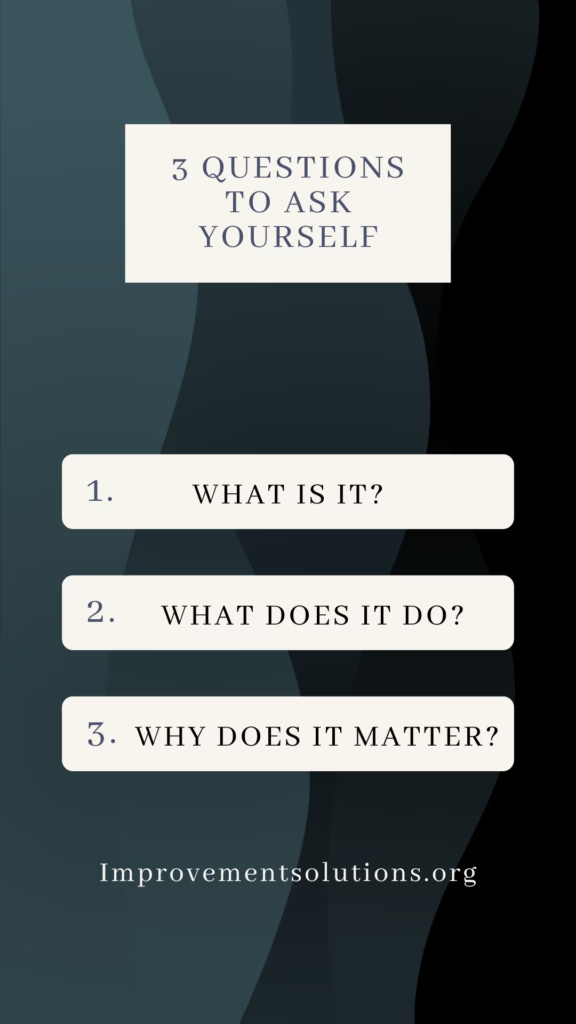
Question 1: What is it?
Start with the basics: What are you explaining?
Don’t overcomplicate it—just clearly define the thing you’re talking about.
Whether it’s a new product, an idea, or a concept, make sure you know it inside and out.
Then, ask yourself, “How would I explain this to someone who has never heard of it before?”
This will help you avoid jargon and keep things simple.
Question 2: What does it do?
Now that you’ve defined what it is, move on to what it does.
Write out in as few words as possible the purpose or outcome of what you’re explaining.
Focus on the benefits, not the mechanics.
Don’t talk about how it works or what it is in technical terms. Instead, think about the results—how it changes things or makes life easier.
For example, if you’re introducing a new project management tool, you wouldn’t start with, “It integrates with every app.”
Instead, you can say, “It helps your team stay on track and meet deadlines faster.” It’s short, clear, and focused on what matters to your audience.
Question 3: Why does it matter?
Finally, ask yourself why it matters.
Why should your audience care?
This is the part where you connect emotionally and show how this product improves lives, solves problems, or opens up new possibilities.
If you can’t explain why it matters, then your audience probably won’t either.
Remember, Steve Jobs didn’t just introduce the iPhone as a phone.
He positioned it as something that would change the way we live, work, and communicate.
That’s the power of the “why”—it makes people connect, resonate, and want to be a part of what you’re offering.
Know Your Audience
Imagine you’re at a family gathering, and your cousin starts talking about the latest tech gadget.
He’s super excited and dives straight into all the features—“It’s got 8GB of RAM, a quad-core processor, and a 5000mAh battery!”—but then you notice your aunt, who has no idea what any of that means, nodding politely but clearly lost.
You know what would have been more helpful?
If he’d started with why the gadget would improve her daily life: “This phone can last all day without charging, so you can talk to your friends, take pictures, and watch videos without worrying about running out of battery.”
That’s the power of knowing your audience.
You don’t want to overwhelm them with unnecessary details they might not understand.
Instead, you want to meet them where they’re at and speak their language.
Assess How Much They Already Know
Think about your audience’s background.
Are they already familiar with the topic, or is this new information for them?
You wouldn’t explain how to ride a bike to someone who’s been cycling for years, right?
Similarly, before you start presenting your ideas, ask yourself: How much does my audience already know?
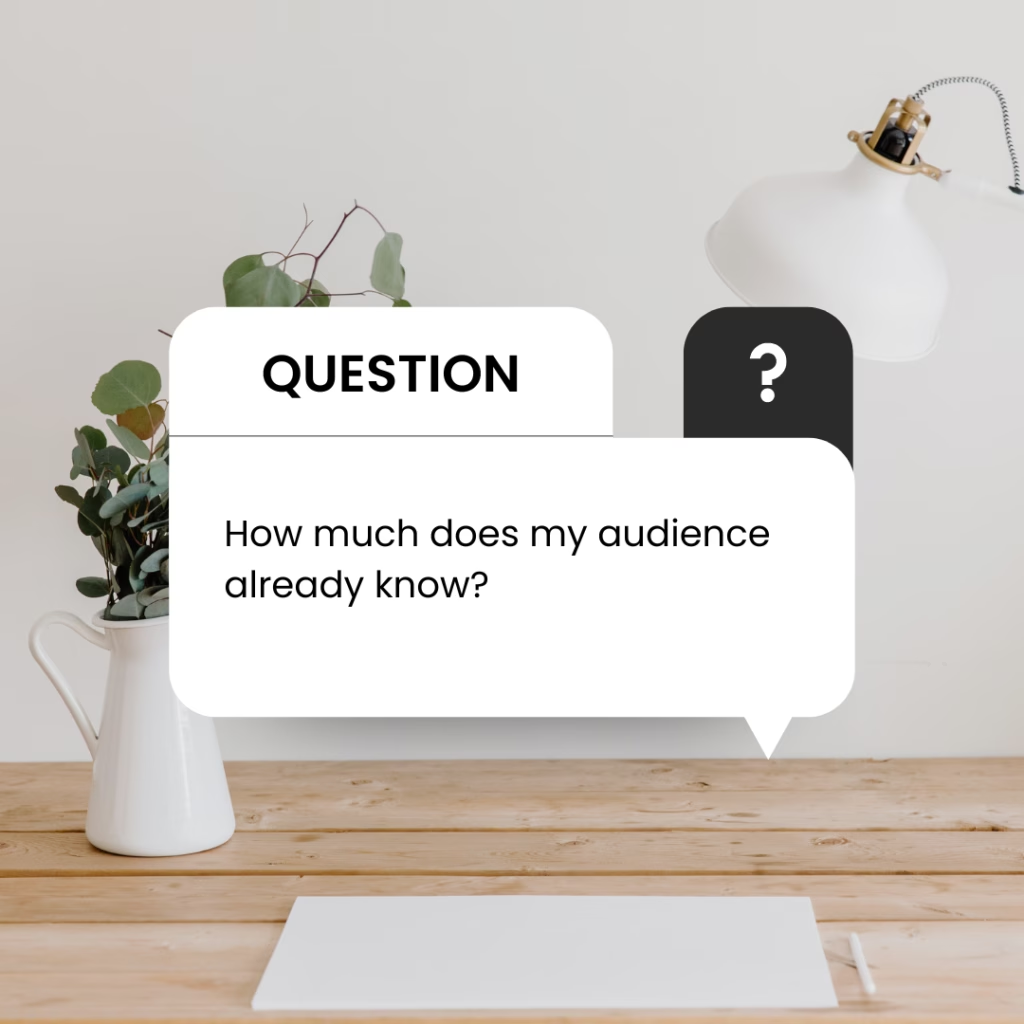
The way you present your message will look very different depending on their level of understanding.
For example, if you’re talking to a group of tech professionals about a new software tool, you can skip over basic concepts and dive right into how it works and why it’s a game-changer for their industry.
On the other hand, if your audience is unfamiliar with the topic, you’ll want to take a step back and explain the basics first.
Assessing what your audience already knows helps you avoid overloading them with unnecessary details or assuming they understand jargon or concepts you’re throwing around.
Ask Questions to Gauge Their Understanding
Here’s a little trick that helps in real-time communication: Ask questions!
Whether you’re speaking face-to-face, in a meeting, or even in an email, you can always gauge where your audience is by checking in with them.
When we are speaking at a workshop or presentation, we often ask questions like, “Does that make sense so far?” or “Has anyone used something like this before?”
These questions help me know whether I need to slow down, explain things in more detail, or keep moving forward.
It’s like checking in with a friend during a conversation—making sure you’re both on the same page.
If you’re writing, you could use phrasing like, “I’d love to hear your thoughts on this!” or “Is this something you’ve experienced before?”
Asking questions keeps the conversation going and ensures that you’re not talking past your audience.
Don’t Talk Down to Them
Let’s be honest: we’ve all been in that situation where someone explains something to us like we’re beginners, and it’s not a great feeling.
If you’re in a meeting and someone talks to you like you don’t know the first thing about the subject, you probably start to tune them out.
It’s not about the topic—it’s about the way they make you feel.
When you’re communicating, don’t assume your audience is ignorant.
Just because they don’t know everything about the topic doesn’t mean they aren’t smart or capable of understanding.
It’s like explaining how to use a smartphone to someone who’s used a phone for years—they may not know all the new features, but they still understand the basics.
Be mindful of how you frame your words.
It’s not about dumbing things down—it’s about making sure the information is accessible without making your audience feel small.
Show respect for their ability to grasp the topic by speaking clearly and kindly, not in a patronizing tone.
Don’t Introduce Concepts They’re Not Ready For
Here’s a quick story:
I remember when I first started learning to play guitar.
I was so excited to learn all the cool techniques and chords I’d seen my favorite musicians play.
But when I went to my first lesson, my teacher didn’t start by showing me how to play a solo or use fingerpicking techniques.
Instead, she taught me how to hold the guitar properly and play simple chords.
It would’ve been overwhelming (and frustrating) if she’d thrown me into complex techniques before I understood the basics.
The same concept applies to communication.
If you try to introduce concepts your audience isn’t ready for, they’ll be confused or disengaged.
Think of it like a gradual climb up a hill.
You can’t rush to the top without first gaining some traction.
Start with the essentials, and as your audience becomes more comfortable, you can introduce more advanced ideas.
You want to build their understanding, not overwhelm them with new concepts too quickly.
Effective Explanation Techniques
Now that you know your audience and have a good grasp of your message, it’s time to think about how you’ll structure that message.
A great explanation isn’t just about what you say—it’s about how you say it.
The way you organize your thoughts can make a world of difference in whether your audience grasps the idea or gets lost along the way.
Let’s break down some simple, effective techniques to help you communicate with clarity and impact.
Structure Your Message
Think about a time you were trying to follow a recipe or a tutorial online, and the instructions were all over the place.
Frustrating, right?
That’s what happens when information isn’t structured well.
It leaves your audience feeling confused and overwhelmed. To keep things clear and engaging, here are some techniques that will help you deliver your message effectively.

Put the Most Relevant Info at the Beginning
Think back to the last time you read an article or email.
Did you dive into the details first or were you looking for the bottom line right away?
Most of us are guilty of scanning to the end to find out the main point. And that’s exactly what your audience will do, too.
When you’re explaining something, start with the most important piece of information.
This way, even if someone only catches the first few sentences, they’ll walk away with the key takeaway.
Imagine explaining a new software tool at work.
Instead of starting with how it works, begin by saying, “This tool will save your team 10 hours a week in manual work.”
That’s a benefit anyone can understand right away.
Once you’ve hit them with the key point, you can then move into the details.
This keeps your message focused and ensures people know why they should care right from the start.
Break Up the Information
If you’ve ever been handed a massive chunk of text or had someone speak in one long, drawn-out sentence, you know how easy it is to zone out.
Our brains naturally crave structure, so it’s important to break down complex information into bite-sized pieces.
Let’s say you’re explaining a new project management process to your team. Instead of launching into the entire process in one breath, break it up into clear steps:
- Step 1: What’s the first thing they need to do?
- Step 2: What comes next?
- Step 3: What should they focus on at the end?
This approach gives people a roadmap to follow, and they can absorb the information more easily.
Use bullet points, numbered lists, or short paragraphs when you’re writing.
If you’re speaking, pause between points and check in with your audience to make sure they’re following along.
Keep it Simple and Avoid Jargon
Let’s say you’re explaining a new app to a group of non-tech-savvy people.
It’s tempting to throw around terms like “cloud-based,” “integration,” or “user interface.”
But these words can confuse or alienate your audience.
Instead, deliver the details in plain language.
For example, instead of saying, “This app integrates seamlessly with your CRM,” you could say, “This app works with the tools you already use, so everything stays connected and easy to manage.”
See the difference?
Simple language creates clarity, and people feel more comfortable when they understand exactly what you mean.
Avoiding jargon doesn’t mean dumbing things down. It just means that you’re being considerate of your audience’s experience and meeting them where they are.
Make it Relatable
At the end of the day, people remember stories and experiences more than abstract concepts or technical details.
When you make your message relatable, it’s not just about delivering information—it’s about connecting with your audience on a deep level.
By weaving in stories, comparisons, and visuals, you create an explanation that resonates with your audience long after the conversation ends.
Use Storytelling
We’ve all been told a story that made a concept or lesson stick in our minds—something simple, something that brought the idea to life.
That’s the magic of storytelling in communication.
When you use a story, you’re not just presenting dry facts; you’re engaging your audience emotionally, making them feel something that helps them understand the concept.
For example, let’s say you’re explaining a time management technique at work. Instead of diving straight into the theory, you could share a personal experience:
“I used to be all over the place, juggling too many tasks at once, feeling overwhelmed. Then I learned about time-blocking—where you set specific times for each task. The first time I tried it, I felt so much more organized, and I could see exactly where my time went. By the end of the week, I realized I was getting more done with less stress.”
By sharing your own story, you’re showing your audience not just how something works but why it works through real-life experience.
This approach makes your explanation feel more tangible and less abstract, so your audience can connect with it on a personal level.
Compare New Concepts to Familiar Ones
Sometimes, the most effective way to explain something new is to compare it to something people already understand.
Think about how many times we’ve heard the internet described as a “web”—it’s a familiar, simple image that helps people conceptualize something complicated.
Let’s say you’re explaining a new app that helps track team progress.
Instead of diving into technical details about data syncing and cloud storage, you could compare it to something everyone is familiar with: “Think of this app like a team calendar, but instead of just marking dates, it tracks all the tasks, deadlines, and progress in one place. It’s like a digital project manager right in your pocket.”
This comparison makes the new concept much easier to grasp.
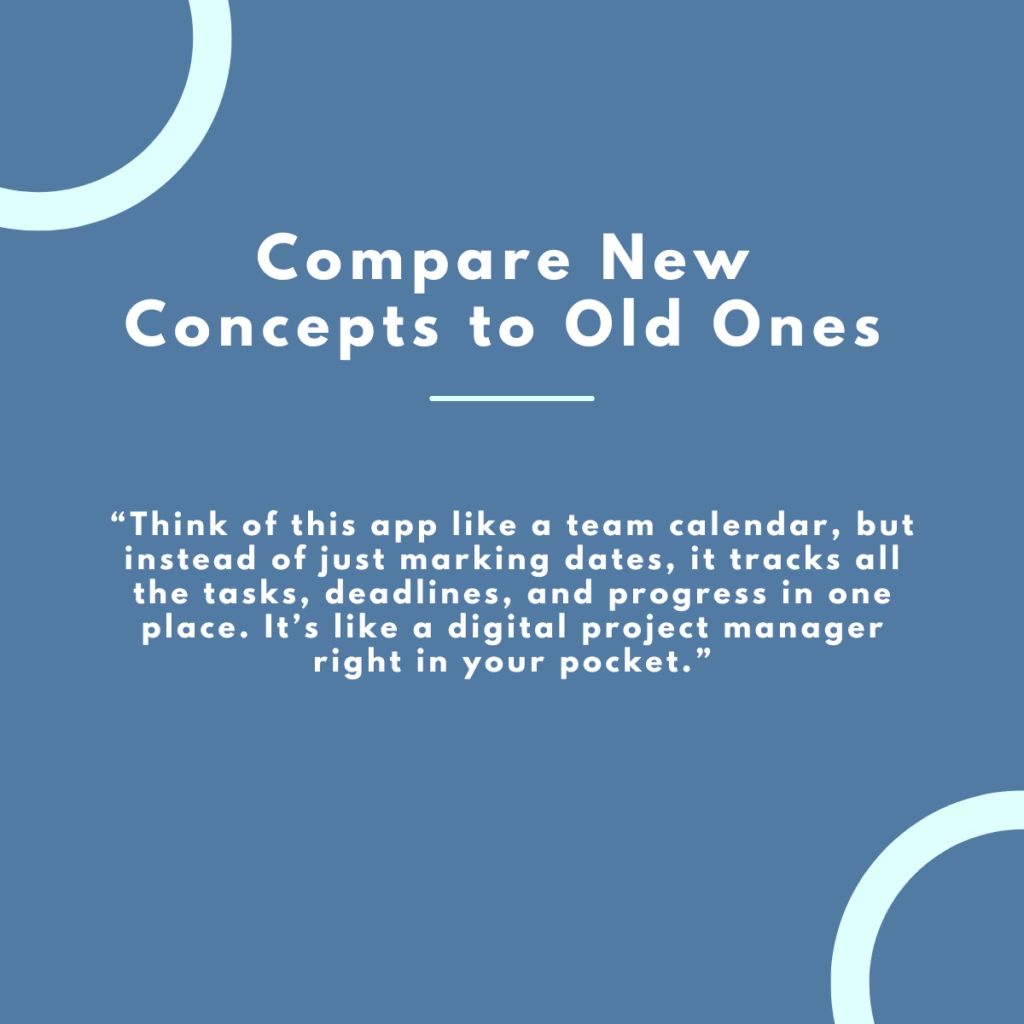
By relating it to something people already use, you give them a mental shortcut to understanding how it works.
Use Visual Cues
As much as we love words, our brains are wired to process visuals faster and more effectively than text alone.
That’s why incorporating visual cues into your explanation can be a game-changer.
Whether you’re explaining something in a presentation or over a Zoom call, visuals help illustrate your point and break down complex ideas.
Imagine you’re explaining the layout of a new office space.
Instead of just describing it, show a simple diagram that highlights key areas.
This gives your audience a clear, concrete understanding of what you’re talking about, and it helps them picture it in their minds.
Visual cues can also be as simple as using metaphors or gestures while speaking.
If you’re explaining the concept of teamwork, for example, you might stretch your arms wide apart and then bring them together, showing how everyone connects and works together.
These physical cues make your explanation more dynamic and help reinforce your message.
Engage Your Audience
Even the clearest explanation can fall flat if your audience isn’t engaged.
It’s not just about what you say—it’s about how you involve your listeners, how you read their reactions, and how you adjust in real time to keep them with you.
If you want your message to stick, you need to turn your audience from passive listeners into active participants.
Make it Interactive
Think about the last time you sat through a long-winded explanation that felt like a one-way lecture.
You probably zoned out at some point, right?
Now, think about a time when someone explained something to you in a way that made you feel involved—maybe they asked for your opinion, gave you a quick challenge, or had you try something yourself.
Which one stuck with you?
Engagement isn’t just about talking to people; it’s about pulling them into the conversation. If you’re explaining something in a meeting, try asking a simple question:
“Has anyone ever struggled with managing their inbox?”
By getting a response—even just a nod—you’re making your audience part of the explanation. If you’re in a one-on-one conversation, you can ask:
“How do you usually tackle this problem?”
This invites them to share their thoughts, making them more invested in the discussion.
The more interactive you can make your explanation—whether through questions, demonstrations, or hands-on activities—the more memorable it will be.
Use Appropriate Body Language
Your words matter, but your body language reinforces your message.
Imagine you’re explaining something exciting, but your arms are crossed, your face is expressionless, and your voice is monotone.
Your audience might hear your words, but they won’t feel your enthusiasm.
Now, picture someone explaining an idea while leaning forward slightly, using their hands to illustrate key points, and making eye contact.
It feels more engaging, right?
Your body language should match the energy of your explanation.
- Use gestures to highlight key points.
- Make eye contact to show confidence and connection.
- Keep an open posture to appear approachable and engaged.
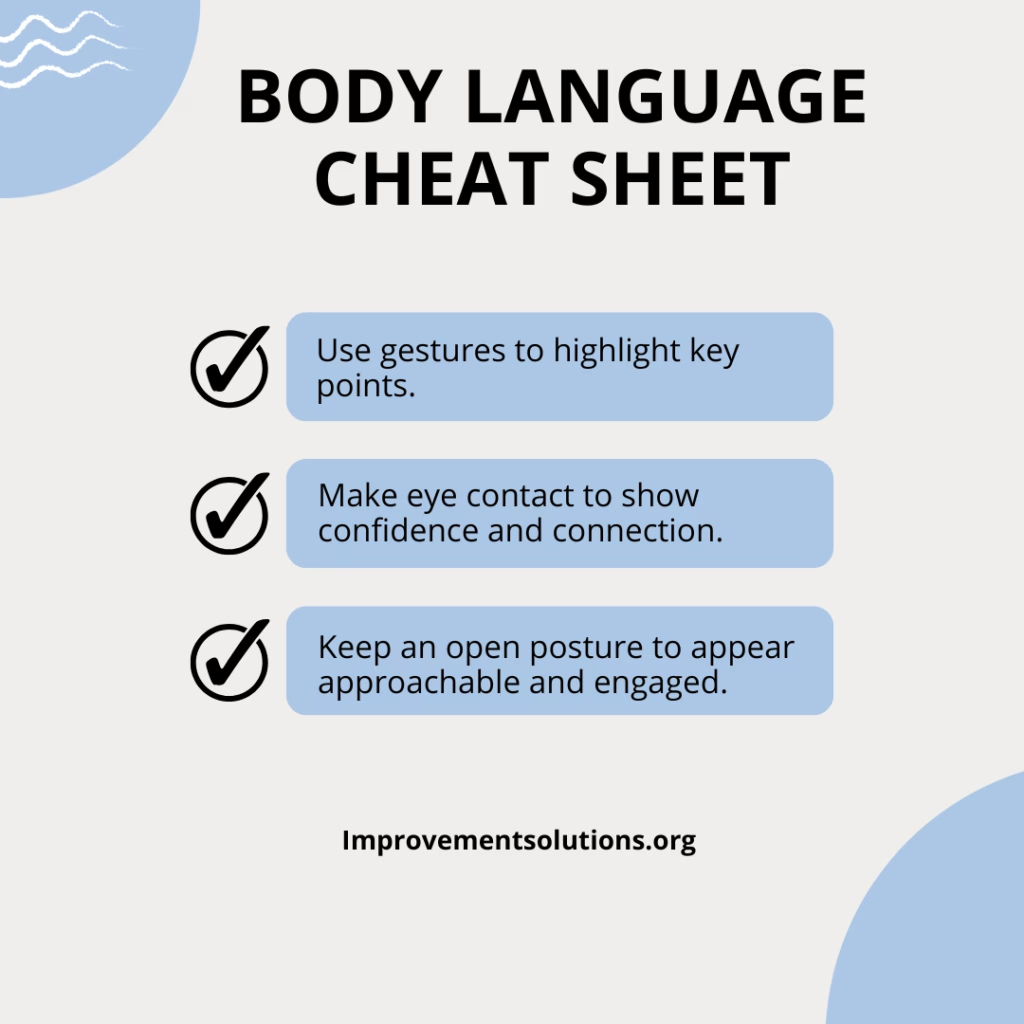
Even in virtual settings, body language matters.
Sitting upright, using hand gestures, and varying your facial expressions can make your explanation feel dynamic and engaging.
Watch for Engagement Signals
When you’re explaining something, your audience is constantly giving you feedback—even if they’re not saying a word. You just have to pay attention.
Look for signs of engagement like:
✅ Nods of agreement
✅ Leaning in
✅ Taking notes or asking questions
These cues tell you that your audience is following along and interested.
If you see these signs, keep going! They’re with you.
Notice Signs of Confusion
On the flip side, sometimes people get lost—but they might not always tell you.
That’s why it’s crucial to watch for subtle signs of confusion, such as:
🚩 Furrowed brows
🚩 Lack of eye contact or distracted behavior
🚩 Repeating the same question in different ways
If you notice these, don’t just plow ahead. Instead, pause and check in:
“Does that part make sense?” or “Would it help if I explained it a different way?”
This small adjustment can make a huge difference.
The goal isn’t just to get through the explanation—it’s to make sure your audience truly understands your message.
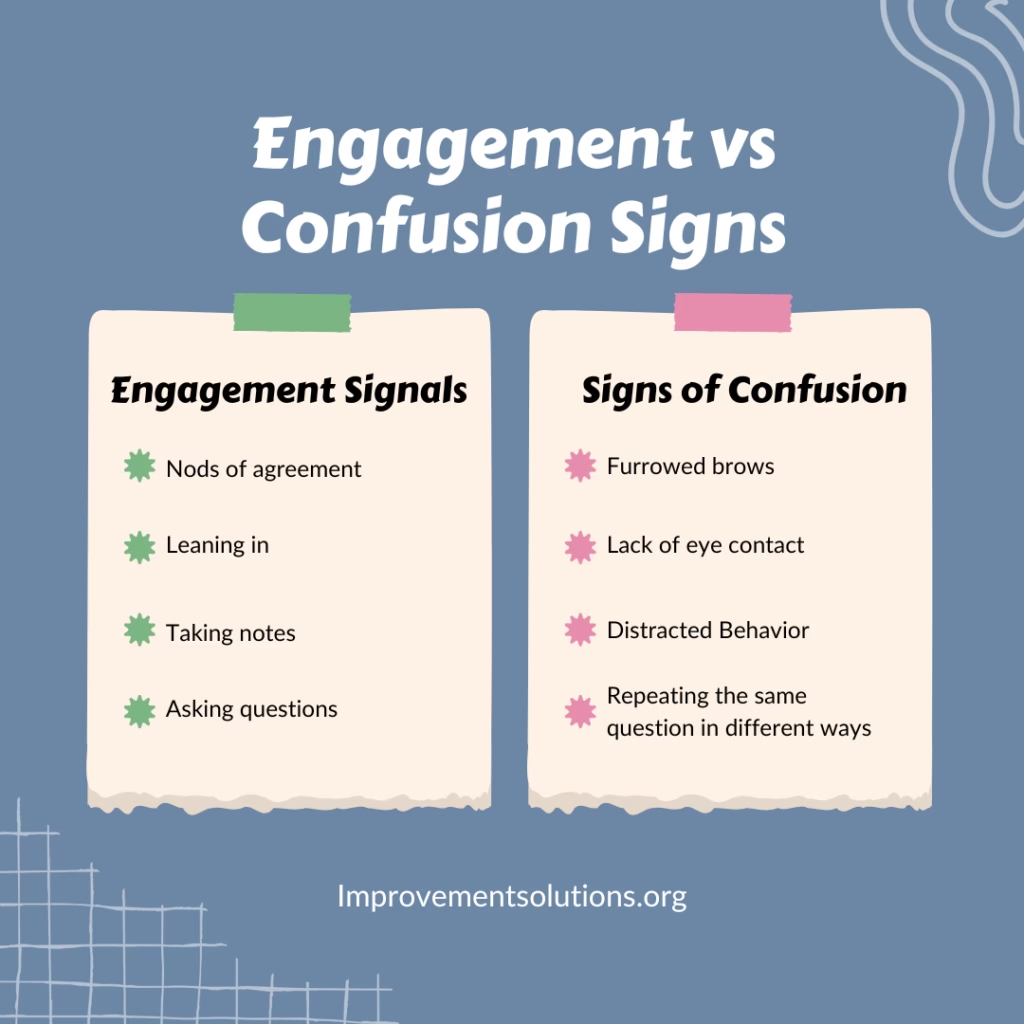
Handling Communication Challenges
Even the best communicators run into roadblocks.
Whether you’re explaining a complex idea, pitching an idea to a skeptical audience, or simply trying to get your point across clearly, challenges will arise.
The good news?
Most of them are avoidable.
Let’s look at some common mistakes people make when explaining things—and how to fix them.
Common Mistakes to Avoid
🚫 Overloading with Information
The Mistake: You try to explain everything at once, dumping too many details too quickly. This overwhelms your audience, and instead of understanding more, they retain less.
The Fix: Stick to the need-to-know information first. Imagine explaining a new software tool: Instead of diving into every feature, start with how it makes their daily tasks easier. Give them just enough to grasp the concept, then expand based on their questions.
🚫 Using Too Much Jargon
The Mistake: You use technical terms or industry-specific language without considering if your audience understands them. While it might make sense to you, it can leave them feeling lost.
The Fix: Swap jargon for simple, everyday language. If you must use a technical term, follow it up with a quick definition or analogy. Steve Jobs was a master at this—he didn’t say the iPod had a “5GB hard drive.” He said, “1,000 songs in your pocket.” Clear, simple, and instantly understandable.
🚫 Not Knowing Your Audience
The Mistake: You assume everyone has the same background knowledge as you. This can lead to either over-explaining (boring your audience) or under-explaining (leaving them confused).
The Fix: Take a moment to assess your audience’s level of understanding. If you’re unsure, start with a broad explanation and adjust based on their responses. A quick, “Are you familiar with this?” can prevent a lot of frustration.
🚫 Talking Without Engaging
The Mistake: You deliver information like a lecture, without checking in with your audience. If they’re silent or disengaged, you won’t know if they’re following along.
The Fix: Make your explanation a two-way conversation. Ask questions, encourage feedback, and look for engagement cues like nodding or eye contact. If you notice blank stares, it’s time to adjust your approach.
🚫 Ignoring Visual or Physical Cues
The Mistake: You rely solely on words when a diagram, metaphor, or gesture could make the concept clearer.
The Fix: Use simple visuals, real-world comparisons, or even hand gestures to reinforce your message. People process images faster than text, so a quick sketch or example can make all the difference.
🚫Not Checking for Understanding
The Mistake: You assume that just because you explained something, your audience understood it.
The Fix: Pause and ask, “Does this make sense?” or “How would you explain this in your own words?” This gives your audience a chance to process the information and lets you course-correct if needed.
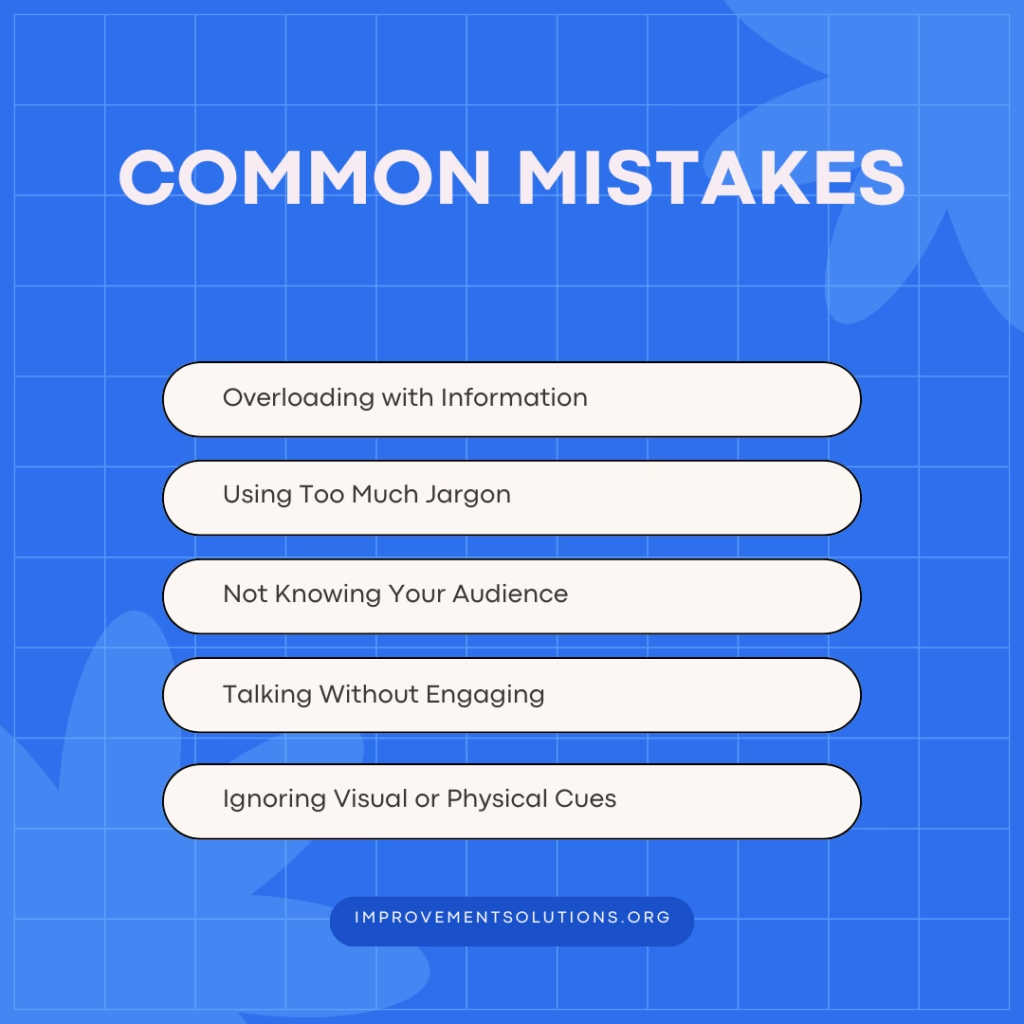
Managing Questions and Objections
Questions and objections are an inevitable part of any communication.
The way you handle these moments can make or break the effectiveness of your message.
It’s not just about answering questions—it’s about showing your audience that you’re engaged, approachable, and capable of addressing their concerns.
How to Handle Questions
When someone asks a question, it can feel like they’re testing you.
Maybe you’re not sure of the answer or you fear they might throw you off track.
First, stay calm and composed.
When you’re in the middle of explaining something, a question doesn’t have to derail your flow.
Instead of rushing to answer immediately, pause and give a thoughtful response.
Here’s a simple process:
- Acknowledge the question: “Great question!” or “I see where you’re coming from…” This shows respect for the person’s input and helps create a welcoming, open environment.
- Take your time: If you don’t have an immediate answer, it’s okay to take a moment to gather your thoughts. Don’t rush to fill the silence.
- Answer clearly: Keep your answer concise and to the point. If necessary, provide an example to illustrate your answer.
Addressing Concerns and Objections
Objections can feel uncomfortable.
They might make you feel like the person disagrees with you, or worse, that they’re questioning your expertise.
However, objections are simply an opportunity to clarify your point and ensure everyone is on the same page.
Imagine you’re presenting a new marketing plan to a team, and one of your colleagues says, “This sounds great, but I don’t think it’s going to appeal to our target audience.”
Instead of getting defensive, you could see it as a chance to dive deeper.
You could say, “I understand your concern, and here’s why I think this will work…” and offer examples or data that address the objection.
When an objection arises, it’s important to stay calm and open-minded.
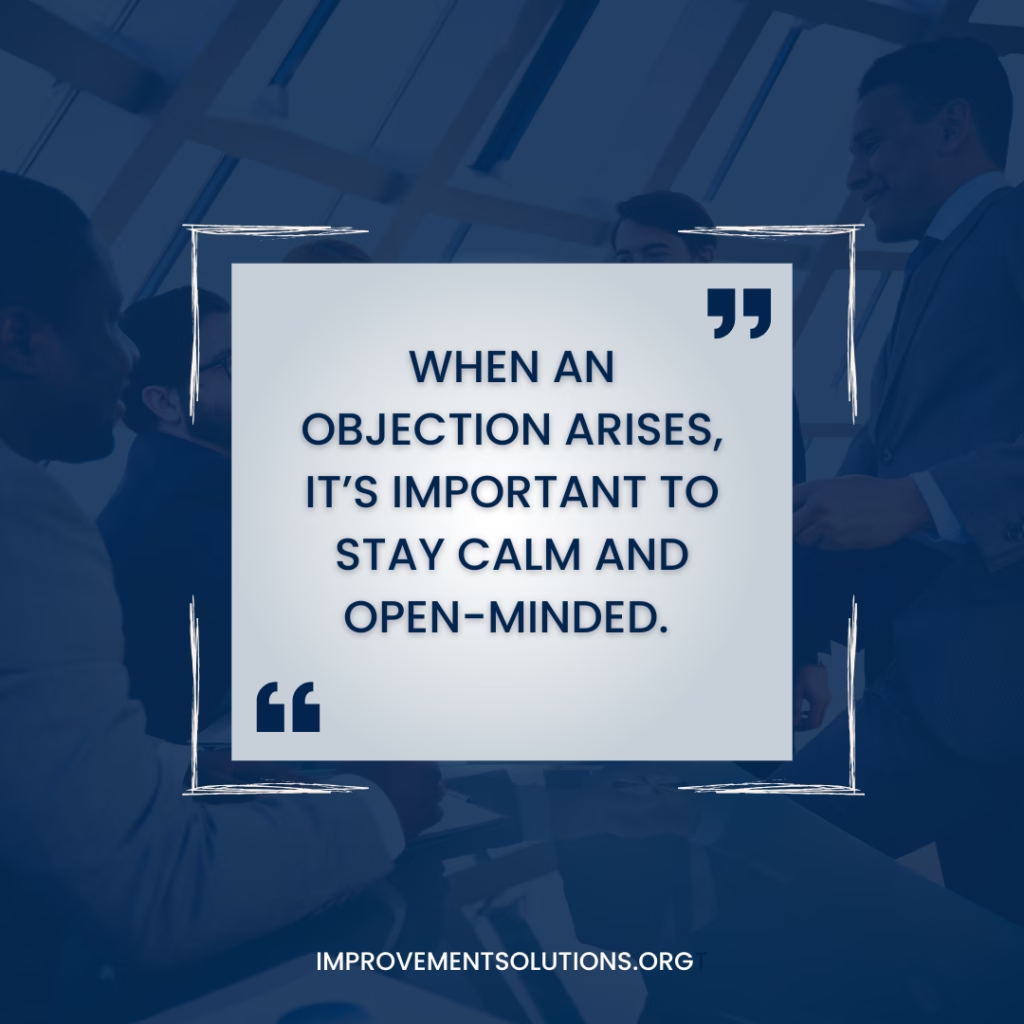
Instead of reacting emotionally, ask clarifying questions to ensure you fully understand the concern.
You might say, “Can you tell me more about why you feel that way?”
Once you understand the concern, address it thoughtfully and provide supporting information or examples that strengthen your position.
Remember, objections are just a part of the process, and responding with patience builds trust.
Confirming Understanding
After answering a question or addressing an objection, how do you know if your audience understood your message?
Sometimes, people may nod in agreement, but they may still have confusion.
If that happens, it can lead to misunderstandings later on.
Imagine you’re teaching a group how to use a new software tool.
After giving instructions, you ask, “Does everyone understand?” People may say yes, but what you really want to know is whether they can apply what you’ve explained.
One simple way to confirm understanding is by asking someone to paraphrase what you’ve just explained.
You could say, “Can you explain what we’ve covered so far in your own words?” or “What’s your understanding of the next step?”
This ensures that they’ve not only heard the information but also processed it in a way that makes sense to them.
It gives them the opportunity to ask follow-up questions if needed.
Another effective approach is to ask for feedback after a presentation or meeting.
Something as simple as, “Do you feel comfortable with the next steps, or is there something you’d like me to clarify?” invites your audience to share their level of understanding and helps avoid any surprises later.
Ensuring Success
There’s one final step to ensure that your communication is truly impactful: consistency.
It’s not just about getting it right once; it’s about applying these techniques regularly so that they become second nature.
Think of it this way: the first time you try to explain something complicated, it may not go perfectly.
You might stumble or get some questions you weren’t prepared for.
But each time you apply these strategies, you’ll find it easier to break down complex ideas and communicate more effectively.
Whether you’re delivering a presentation, writing an email, or even having a conversation, the goal is to keep refining your approach and make communication a powerful tool in your toolkit.
Mastering the art of explanation takes practice, but it’s worth the effort.
By taking the time to prepare, understanding your audience, and using clear, relatable language, you can turn complex ideas into conversations that everyone can understand.
You’ll not only make your message clearer, but you’ll also build trust, engagement, and stronger relationships with your audience.
If you’re ready to take your communication skills to the next level, we’re here to help.
At Continuous Improvement Solutions, we specialize in coaching individuals and organizations to communicate more effectively.
From creating clear messaging to training on how to present your ideas with confidence, our tailored coaching services are designed to give you the tools to succeed.
Whether you’re looking to refine your writing, enhance your public speaking skills, or develop strategies for more effective communication, we can help you achieve your goals.
Contact us today to learn more about how we can support your communication growth.
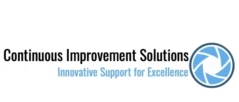
I read through this.
Quite a review of what many of us once studied.